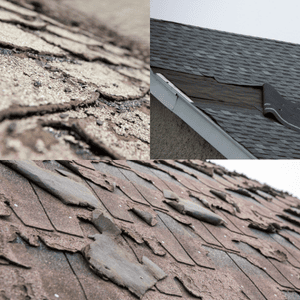Winter is right around the corner, and your roof is the first line of defense against everything the season throws at it—rain, snow, ice, and freezing temperatures. Ignoring roof repair needs can lead to big headaches when cold weather hits, but with a few proactive steps, you can avoid costly damage and keep your home warm and dry.
In this guide, we’ll walk you through ten essential roof repair tips to ensure your home is secure, winter-ready, and free from preventable issues. From quick inspections to professional repairs, these steps will give you peace of mind knowing your roof is ready to take on the season.
1. Inspect for Missing or Damaged Shingles

- Why It Matters: Shingles are the roof’s first layer of protection, creating a barrier that deflects water and resists wind. Missing or damaged shingles leave your roof vulnerable to leaks, mold growth, and potential water damage during winter.
- How to Check: Walk around your home and look up to spot areas where shingles might be missing, cracked, or lifting. Pay attention to any shingles that appear darker than others, which could indicate they’re wet or damaged.
- Pro Tip: If you find multiple missing or damaged shingles, it may be time to call a professional for an inspection. Ignoring even a few missing shingles can lead to leaks and costly repairs down the road.
2. Check Flashing Around Chimneys and Skylights
- Why It Matters: Flashing is the metal or rubber that seals areas where water could enter, such as around chimneys, skylights, and vents. Damaged flashing creates weak points where water can seep through, causing damage to the roof structure or interior.
- How to Check: Carefully inspect the flashing around roof protrusions. Look for cracks, gaps, or any areas where the flashing has pulled away from the roof surface.
- Pro Tip: While you can inspect flashing on your own, repairs are best left to a professional if damage is found. Properly installed flashing can save you from extensive damage and mold growth.
3. Clear Out Gutters and Downspouts
- Why It Matters: Clogged gutters prevent water from draining properly, allowing it to pool on your roof or at the foundation. During winter, this trapped water can freeze and form ice dams, which can damage shingles and gutters.
- How to Check: Clean your gutters of any leaves, twigs, and debris that might be blocking water flow. Check that downspouts are clear and directing water away from your home’s foundation.
- Pro Tip: Consider adding gutter guards to help keep leaves and debris out, reducing future maintenance. If you have tall trees around your home, cleaning gutters regularly is especially important to avoid clogs.
4. Look for Signs of Sagging or Warping

- Why It Matters: Sagging or warping can signal serious structural issues, such as water damage or weakened support beams. Heavy snow or ice can put extra pressure on these areas, increasing the risk of collapse or further damage.
- How to Check: Stand back from your home and look at your roofline. Notice any areas that dip, sag, or appear uneven. Inside, check for any sagging in the ceiling, particularly in the attic.
- Pro Tip: If you detect significant sagging, it’s best to call a professional right away. Structural repairs can be costly but are essential to maintaining a safe, secure home.
5. Examine Attic Insulation and Ventilation
- Why It Matters: Proper insulation and ventilation in the attic play a key role in preventing roof damage during winter. Good insulation keeps heat from escaping, which in turn prevents ice dams from forming on the roof.
- How to Check: In your attic, check that insulation is evenly distributed, with no signs of compression or gaps. Make sure that vents are unobstructed and allowing airflow.
- Pro Tip: Adding insulation or improving ventilation can be an affordable way to enhance energy efficiency. If you notice condensation or frost buildup in the attic, it may be a sign of poor ventilation, which should be addressed before winter hits.
6. Remove Overhanging Tree Branches
- Why It Matters: Overhanging branches can scrape against your roof during windy or icy conditions, damaging shingles. Worse, these branches can break under the weight of ice and snow, potentially falling onto your roof and causing major damage.
- How to Check: Identify any branches hanging over your roof, especially those near the edges or center where the weight of snow or ice could be a problem.
- Pro Tip: Keep branches trimmed to at least six feet away from your roof. This prevents damage and helps keep leaves and debris out of your gutters.
7. Inspect for Shingle Granules in Gutters

- Why It Matters: Shingle granules provide an additional layer of protection against UV rays and weather wear. Granules in your gutters can signal that shingles are deteriorating, reducing their effectiveness and potentially exposing your roof to further damage.
- How to Check: After cleaning out gutters, look for sand-like particles. Finding a few granules is normal, but if you see large amounts, it’s a sign your shingles are aging and may need replacement.
- Pro Tip: If granule loss is significant, consider replacing the affected shingles before winter. Neglecting this step could lead to leaks or heat loss.
8. Repair or Replace Damaged Flashing

- Why It Matters: Replace damaged flashing to protect roof seams and joints, which are more susceptible to water entry. Winter storms and ice buildup put extra pressure on these vulnerable areas.
- How to Check: Examine flashing around chimneys, vents, and skylights for rust, cracks, or gaps. If flashing is loose or damaged, water can seep into your home’s structure.
- Pro Tip: Professionals can replace damaged flashing with materials suited to withstand winter weather. If you see multiple problem areas, it may be best to have a professional handle the repair.
9. Look for Interior Warning Signs Like Water Stains
- Why It Matters: Some roof issues are easier to spot indoors than on the roof itself. Water stains, mold, and peeling paint can all signal roof leaks or poor insulation that could lead to bigger issues over the winter.
- How to Check: Walk through your home and look for water stains on ceilings, mold growth in the attic, or peeling paint around windows. Each of these issues may point to roof or insulation problems.
- Pro Tip: Small stains or drafts might seem minor, but they often indicate a larger issue. Addressing them now can prevent significant damage and repair costs later.
10. Schedule a Professional Roof Inspection
- Why It Matters: A professional inspection can catch problems that may not be visible to the untrained eye. Roofers have specialized equipment and knowledge to thoroughly assess your roof’s condition.
- How to Check: Contact a local roofing company, like CK Restoration, to schedule an inspection. Many companies offer winter preparation services specifically tailored to identifying seasonal risks.
- Pro Tip: Book your inspection early to avoid the winter rush. A proactive inspection can save you from emergency repairs during the colder months.
Roof Repair Tips to Protect Your Home All Winter
Roof maintenance and repair now can ensure your roof is ready to stand strong all winter. By addressing issues like missing shingles, damaged flashing, and sagging areas, you can prevent small problems from turning into big headaches.
Whether you’re handling minor repairs on your own or bringing in a professional, each of these roof repair tips will help protect your home, your comfort, and your budget through the winter months.
Need a hand preparing your roof for winter? Contact CK Restoration today for a professional inspection and repair services that ensure your roof is secure. Don’t wait—schedule your consultation now and enjoy a warm, worry-free winter!Ready for a full roof makeover? Read more from our blog- The Ultimate Homeowner’s Guide to Roof Types: Discover Which One is Perfect for You!

